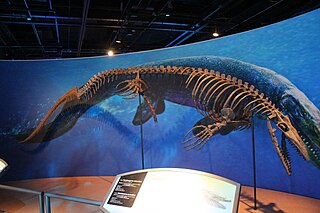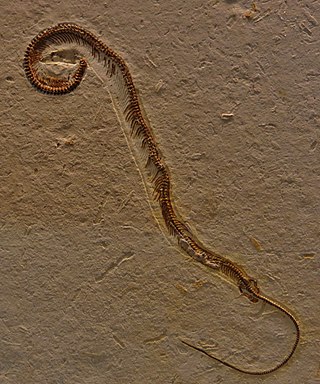
Squamata is the largest order of reptiles, comprising lizards and snakes. With over 11,500 species, it is also the second-largest order of extant (living) vertebrates, after the perciform fish. Members of the order are distinguished by their skins, which bear horny scales or shields, and must periodically engage in molting. They also possess movable quadrate bones, making possible movement of the upper jaw relative to the neurocranium. This is particularly visible in snakes, which are able to open their mouths very wide to accommodate comparatively large prey. Squamates are the most variably sized living reptiles, ranging from the 16 mm (0.63 in) dwarf gecko to the 6.5 m (21 ft) reticulated python. The now-extinct mosasaurs reached lengths over 14 m (46 ft).

Ophidia is a group of squamate reptiles including modern snakes and reptiles more closely related to snakes than to other living groups of lizards.

Mosasaurs are an extinct group of large aquatic reptiles within the family Mosasauridae that lived during the Late Cretaceous. Their first fossil remains were discovered in a limestone quarry at Maastricht on the Meuse in 1764. They belong to the order Squamata, which includes lizards and snakes.

Pythonomorpha was originally proposed by paleontologist Edward Drinker Cope (1869) as a reptilian order comprising mosasaurs, which he believed to be close relatives of Ophidia (snakes). The etymology of the term Pythonomorpha comes from the Greek Python and morphe ("form"), and refers to the generally serpentine body plan of members of the group. Cope wrote, "In the mosasauroids, we almost realize the fictions of snake-like dragons and sea-serpents, in which men have been ever prone to indulge. On account of the ophidian part of their affinities, I have called this order Pythonomorpha." Cope incorporated two families, the Clidastidae and the Mosasauridae.

Adriosaurus is an extinct genus of squamate which lived in what is now Slovenia and other parts of Europe during the Late Cretaceous. It was small, snake-like reptile, with type species measuring up to 30 cm (12 in) in length. This is the first fossil record of vestigial limbs in lizards. It lost its manus and forearm completely in order to elongate its axial skeleton. These unique anatomical features led to discussions of the evolutionary patterns of limb reduction in Squamata.

Mecistotrachelos is an extinct genus of gliding reptile from the Late Triassic of Virginia. It is generally interpreted as an archosauromorph, distantly related to crocodylians and dinosaurs. The type and only known species is M. apeoros. This specific name translates to "soaring longest neck", in reference to its gliding habits and long neck. This superficially lizard-like animal was able to spread its lengthened ribs and glide on wing-like membranes. Mecistotrachelos had a much longer neck than other gliding reptiles of the Triassic such as Icarosaurus and Kuehneosaurus. It was probably an arboreal insectivore.

Taniwhasaurus is an extinct genus of mosasaurs that lived during the Campanian stage of the Late Cretaceous. It is a member of the subfamily Tylosaurinae, a lineage of mosasaurs characterized by a long toothless conical rostrum. Two valid species are attached to the genus, T. oweni and T. antarcticus, known respectively from the fossil record of present-day New Zealand and Antarctica. Two other species have been nominally classified within the genus, T. 'capensis' and T. 'mikasaensis', recorded in present-day South Africa and Japan, but their attribution remains problematic due to the fragmentary state of their fossils. The generic name literally means "taniwha lizard", referring to a supernatural aquatic creature from Māori mythology.

Eupodophis is an extinct genus of snake from the Late Cretaceous period. It has two small hind legs and is considered a transitional form between Cretaceous lizards and limbless snakes. The feature, described as vestigial, was most likely useless to Eupodophis. The type species Eupodophis descouensi was named in 2000 and resides now in the paleontology section of the Mim Museum in Beirut, Lebanon. The specific name is dedicated to the French naturalist Didier Descouens.

Carsosaurus is a genus of extinct amphibious reptiles, in the mosasaur superfamily, containing only the species Carsosaurus marchesetti. It is known from a single individual that lived during the Upper Cretaceous in what is now Slovenia. The specimen is well-preserved, containing many different bones as well as some skin impressions and sternal cartilage. While more remains are needed to be certain, it is generally thought to belong to Aigialosauridae. In life, it was an amphibious creature that spent most of its time on land, although its later relatives would become fully aquatic.
Parviraptor is a genus of squamate containing one species, Parviraptor estesi, from the Late Jurassic (Tithonian) or Early Cretaceous (Berriasian) Purbeck Limestone Formation of Dorset, England. A second species, Parviraptor gilmorei, was described from the Late Jurassic Morrison Formation of Western North America; it was present in stratigraphic zone 4. However, the second species was subsequently transferred to a separate genus Diablophis. An indeterminate species is known from the Bathonian aged Kirtlington Mammal Bed.
Acteosaurus is an extinct genus of aquatic lizard that lived in the upper Cretaceous period. Its species, A. tommasinii and A. crassicostatus, were described in 1860 and 1993. Though A. crassicostatus is probably a junior synonym for Adriosaurus suessi, A. tommasinii was found to be similar to coniasaurs, mosasauroids, and a sister taxon to modern snakes in 2010.

Huehuecuetzpalli mixtecus is an extinct lizard from the Early Cretaceous Tlayúa Formation in Tepexi de Rodríguez, Central Mexico. Although it is not the oldest known lizard, Huehuecuetzpalli may be amongst the most basal members of Squamata, making it an important taxon in understanding the origins of squamates.

The Tethysaurinae are a subfamily of mosasaurs, a diverse group of Late Cretaceous marine squamates. Members of the subfamily are informally and collectively known as "tethysaurines" and have been recovered from North America and Africa. Only two tethysaurine genera are known, Pannoniasaurus and Tethysaurus. The genera Yaguarasaurus and Russellosaurus were previously considered tethysaurines until they were grouped with Romeosaurus in the new subfamily Yaguarasaurinae. A possible member of this clade (subfamily) is a mosasaur specimen known from a maxilla fragment, found in 1960 in the Czech Republic, in Dolní Újezd near Litomyšl.

Megachirella is an extinct genus of lepidosaur, possibly a stem-squamate that lived about 240 million years ago during the Middle Triassic and contains only one known species, Megachirella wachtleri. It is known from a partial skeleton discovered in the Dolomites of Northern Italy and was described in 2003.

Tetrapodophis is an extinct genus of lizard from the Early Cretaceous (Aptian) aged Crato Formation of Brazil. It has an elongate snake-like body, with four limbs. Tetrapodophis has been considered by some authors to be one of the oldest members of Ophidia. However, this classification has been disputed by some other authors, who identify Tetrapodophis as a dolichosaurid much less closely related to snakes.

Dolichosauridae is a family of Cretaceous aquatic lizards. They are widely considered to be the earliest and most primitive members of Mosasauria, though some researchers have recovered them as more closely related to snakes.

Mosasauria is a clade of aquatic and semiaquatic squamates that lived during the Cretaceous period. Fossils belonging to the group have been found in all continents around the world. Early mosasaurians were small long-bodied lizards that inhabited nearshore coastal and freshwater environments; the Late Cretaceous saw the rise of larger marine forms, the mosasaurs, which are the clade's best-known members.
Paleontology or palaeontology is the study of prehistoric life forms on Earth through the examination of plant and animal fossils. This includes the study of body fossils, tracks (ichnites), burrows, cast-off parts, fossilised feces (coprolites), palynomorphs and chemical residues. Because humans have encountered fossils for millennia, paleontology has a long history both before and after becoming formalized as a science. This article records significant discoveries and events related to paleontology that occurred or were published in the year 2018.
This list of fossil reptiles described in 2019 is a list of new taxa of fossil reptiles that were described during the year 2019, as well as other significant discoveries and events related to reptile paleontology that occurred in 2019.















